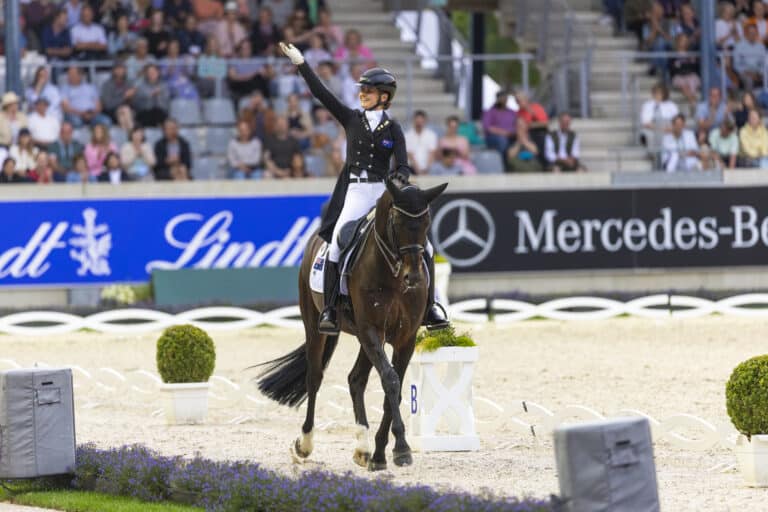Charlotte Dujardin and Gio showing a flying change.
© FEI/Christophe Taniere
Flying Changes – Part III
By Dr Kerry Mack
So my last two blogs we have been talking about flying changes. You have, I hope been practising the preparation! If you haven’t read the last two blogs please go back and read them before you read this one. Good flying changes depend on good preparation.
When you want to start to train the flying changes test the reactions that you want. Build up to the changes by testing the canter transitions, test the counter canter and use change the bend exercise.
My favourite exercise to introduce the changes is as follows:
• at R ride a 10 metre circle right lead
• plan a figure of 8 across the arena between R and S of two 10 metre wide circles (ovals are fine and perhaps better than circles for this exercise)
• you should be changing rein going towards C
• start with some simple changes over I until he starts to anticipate a change of leg here
• then half circle R to I, then leg yield at canter towards M, keeping the shoulder more to the left than the right
• get bend around the left leg
• ask for canter left, going towards C, using your normal leg aids, inside leg on the girth outside leg behind the girth. It is your legs that ask for the change
• at first do the change from the left canter half circle S to I as a simple change, remember train one side at a time
Don’t let the canter get flat or long. The small half circles help keep jump in the canter.
Don’t make the canter too slow and short. Keep it active and balanced and jumping.
Don’t be strong or cranky if there is no change, just simple change.
Do reward any attempt to change at the beginning. come back to walk once you get a flying change and have cantered on enough to settle into the new lead.
Don’t ask for repetitions in the first few lessons.
Do take your time.
Don’t try to swing him on to the new lead. Just give the normal aid to canter left.
Don’t lean forwards and stare at his left shoulder to see if he has changed.
Do keep sitting straight and sit on his hind legs.
Do try to be soft with you new (left) inside rein as this makes a space for his new inside hind leg to jump into.
Don’t try to make him change with the reins.
Do end the lesson if you get a good change, get off and put him away.
When you have a change right to left you can try left to right. If you get a problem go back to an earlier exercise, e.g. simple change.
There are many more exercises, and I will tell you some more later on. Meanwhile remember to have fun!
Kerry.







